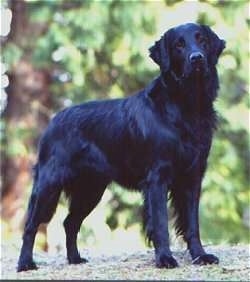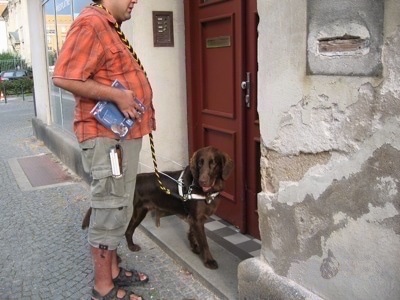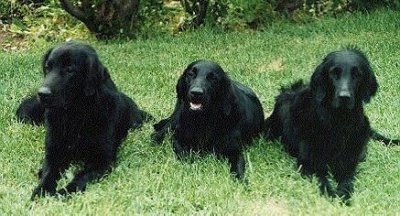Duke the full-grown Flat Coat and Meg the Flat Coat puppy, both have liver-colored coats
flat koh-tid ri-tree-ver 
The Flat-Coated Retriever is a beautiful medium to large sized dog. The head is long with a fairly flat skull. The muzzle is long, deep and strong with a gradual, slight stop. The large nose is black on black dogs and brown on liver dogs. The teeth meet in a scissors or level bite. The medium sized eyes are almond shaped and can be dark brown, or hazel. The well-feathered ears are relatively small compared to the size of the head, hanging to the sides. The chest is deep and wide and the back is short and square. The strong feet are round. The medium length, thick, fine coat lies flat to the body and comes in the more common solid black, a less common solid liver, or a rare yellow with well-feathered legs, tail and chest. The liver and yellow colors come from a recessive gene. The yellow color used to be as common as the liver color, but has been bred out over the years. Some breeders however have accepted the yellow color and are bringing the yellow color back.
The Flat-Coated Retriever is excellent with children and a great family dog with a reliable temperament. Friendly, sweet and high-spirited, it loves everyone, even strangers. It has a puppy-like attitude and always appears to be in good spirits. It loves to play and retrieve, and with enough exercise it will be quiet indoors, saving the activity for the outside. It is an intelligent, loyal companion. This very sociable breed needs lots of gentle but firm leadership from its family. The Flat-Coated Retriever gets along well with dogs and other pets. They are active, obedient and highly trainable, and can get bored easily without variety. Keep training sessions short and fun, without excessive repetition. Be sure to take them for daily walks to satisfy their migration instinct. Flat Coats that are over-excitable are showing signs that they are lacking in the walk. Proper canine to human communication is essential.
Height: 22 - 23 inches (56 - 58 cm)
Weight: 60 - 70 pounds (27 - 32 kg)
Cancer is common in this breed. Hip dysplasia, PRA, CHD, epilepsy and diabetes are occasionally seen.
The Flat-Coated Retriever is not recommended for apartment life. It is relatively inactive indoors and will do best with at least an average-sized yard. This breed needs to be with his family to be happy. It does best when it is allowed to live inside and play outside.
This active dog needs a daily walk or jog to be on its best behavior. Be sure the dog is made to heel beside or behind the person holding the lead, as instinct tells a dog the leader leads the way, and that leader needs to be the human. It especially enjoys the chance to hunt or swim. The Flat-Coated Retriever makes an excellent jogging companion.
Average of 10 years.
About 4 to 8 puppies
The feathered coat of the Flat-Coated Retriever needs only weekly brushings and little, if any, minor trimming. This breed is an average shedder.
The Flat-Coated Retriever was once considered a generic "Labrador" type dog, called a "Retriever Proper." It was developed in the 1800s from various retriever and spaniel water type dogs such as the Newfoundland, Irish Setter, Labrador, Water Spaniels and possibly the Collie. Some of these dogs were born with a flat, wavy coat and eventually they were categorized as a separate breed becoming the Flat-Coated Retriever. The Flat-Coats became very popular until the beginning of the World War when their numbers dwindled and their popularity never reached those high numbers again. More people choose to own a Labrador Retriever or Golden Retriever because they are cheaper and easier to find. The dogs were used by fisherman and hunters. They have a superior sense of smell, are excellent swimmers, and are able to work well in marshy areas. They are wonderful bird dogs, doing very well retrieving on plains and in areas thick with trees and bushes. The Flat-Coated Retriever was recognized by the AKC in 1915. Some of the Flat-Coated Retriever's talents are retrieving, hunting, tracking, watchdog and agility.
Gun Dog, AKC Sporting

Scout the adult black Flat-Coated Retriever

Hnedka the liver Flat-Coated Retriever working as a guide for the blind, photo courtesy of Helena

Tracker, Sadie and Race, three generations of Flat-Coated Retrievers from Inglis Kennels
Todd the liver Flat-Coated Retriever puppy laying in the grass
Todd the liver Flat-Coated Retriever puppy sitting in the grass